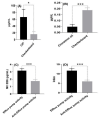Antibacterial and Anti-Efflux Activities of Cinnamon Essential Oil against Pan and Extensive Drug-Resistant Pseudomonas aeruginosa Isolated from Human and Animal Sources
- PMID: 37887215
- PMCID: PMC10604284
- DOI: 10.3390/antibiotics12101514
Antibacterial and Anti-Efflux Activities of Cinnamon Essential Oil against Pan and Extensive Drug-Resistant Pseudomonas aeruginosa Isolated from Human and Animal Sources
Abstract
Pseudomonas aeruginosa is notorious for its ability to develop a high level of resistance to antimicrobial agents. Resistance-nodulation-division (RND) efflux pumps could mediate drug resistance in P. aeruginosa. The present study aimed to evaluate the antibacterial and anti-efflux activities of cinnamon essential oil either alone or combined with ciprofloxacin against drug resistant P. aeruginosa originated from human and animal sources. The results revealed that 73.91% of the examined samples were positive for P. aeruginosa; among them, 77.78% were of human source and 72.73% were recovered from animal samples. According to the antimicrobial resistance profile, 48.73% of the isolates were multidrug-resistant (MDR), 9.2% were extensive drug-resistant (XDR), and 0.84% were pan drug-resistant (PDR). The antimicrobial potential of cinnamon oil against eleven XDR and one PDR P. aeruginosa isolates was assessed by the agar well diffusion assay and broth microdilution technique. The results showed strong antibacterial activity of cinnamon oil against all tested P. aeruginosa isolates with inhibition zones' diameters ranging from 34 to 50 mm. Moreover, the minimum inhibitory concentration (MIC) and minimum bactericidal concentration (MBC) values of cinnamon oil against P. aeruginosa isolates ranged from 0.0562-0.225 µg/mL and 0.1125-0.225 µg/mL, respectively. The cinnamon oil was further used to evaluate its anti-efflux activity against drug-resistant P. aeruginosa by phenotypic and genotypic assays. The cartwheel test revealed diminished efflux pump activity post cinnamon oil exposure by two-fold indicating its reasonable impact. Moreover, the real-time quantitative polymerase chain reaction (RT-qPCR) results demonstrated a significant (p < 0.05) decrease in the expression levels of MexA and MexB genes of P. aeruginosa isolates treated with cinnamon oil when compared to the non-treated ones (fold changes values ranged from 0.4204-0.7474 for MexA and 0.2793-0.4118 for MexB). In conclusion, we suggested the therapeutic use of cinnamon oil as a promising antibacterial and anti-efflux agent against drug-resistant P. aeruginosa.
Keywords: MexB and MexA genes; Pseudomonas aeruginosa; antimicrobial activity; cinnamon oil; efflux pumps.
Conflict of interest statement
The authors declare no conflict of interest.
Figures


References
-
- Qin S., Xiao W., Zhou C., Pu Q., Deng X., Lan L., Liang H., Song X., Wu M. Pseudomonas aeruginosa: Pathogenesis, virulence factors, antibiotic resistance, interaction with host, technology advances and emerging therapeutics. Signal Transduct. Target. Ther. 2022;7:1–27. doi: 10.1038/s41392-022-01056-1. - DOI - PMC - PubMed
-
- Tartor Y., El-Naenaeey E. RT-PCR detection of exotoxin genes expression in multidrug resistant Pseudomonas aeruginosa. Cell. Mol. Biol. 2016;62:56–62. - PubMed
-
- Arzanlou M., Chai W.C., Venter H. Intrinsic, adaptive and acquired antimicrobial resistance in Gram-negative bacteria. Essays Biochem. 2017;61:49–59. - PubMed
LinkOut - more resources
Full Text Sources

